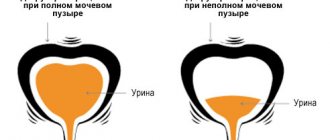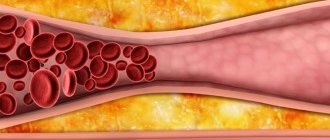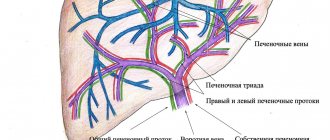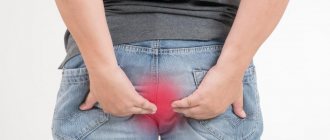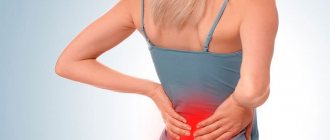Cystitis is an inflammation of the bladder.
The bladder is a hollow organ designed to store urine. Urine is produced by the kidneys and travels down the ureters to the bladder. Urine is removed from the bladder through the urethra (urethra). The walls of the bladder are formed by a special type of muscle; the inside of the organ cavity is lined with mucous membrane.
Most often, inflammation in cystitis affects only the mucous membrane, but in some cases, the muscle tissue of the walls of the bladder can also be involved in the inflammatory process.
Causes of cystitis
Inflammation can be caused by various reasons. For example, toxic and allergic cystitis are distinguished. However, in most cases, cystitis is caused by an infection.
An infection in the bladder can occur in the following ways:
- ascending
route - along the urethra. This is the most common route of infection. In this case, cystitis develops as a complication of urethritis; - descending
route - from the kidney through the ureter (with an inflammatory process in the kidney, for example, chronic pyelonephritis); - lymphogenous
- with the flow of lymph from the pelvic organs (in women - with inflammation of the appendages, endometritis, etc.); - hematogenous
- with blood flow. It is rare, but this way the infection can get from distant foci of inflammation; - in a direct
way - when ulcers break through from the tissues surrounding the bladder into the bladder. Infection can be introduced during surgical or instrumental intervention, as well as during the installation of a catheter.
The causative agent of cystitis is most often Escherichia coli (from 80 to 95% of cases of acute uncomplicated cystitis). This bacterium is normally found in the rectum; if it enters the urethra, it can lead to inflammation. Other bacteria (enterococci, enterobacteria, staphylococci, etc.) can also be the causative agent of cystitis. Another group of pathogens consists of sexually transmitted infections (STIs): chlamydia, trichomonas, mycoplasma, ureaplasma, fungi of the genus Candida (the causative agent of thrush), herpes.
Cystitis is considered a “female” disease, since it mainly affects women. Cystitis in men is rare and, as a rule, is a complication of chronic prostatitis that does not require separate treatment: when inflammation of the prostate gland is relieved, the signs of cystitis also go away.
The fact that women often suffer from cystitis is explained by the structure of the female body. The urethra in women is short and wide; it is located relatively close to the anus. It is easier for E. coli to enter it than into the urethra in men, and it is easier for it to travel up it into the bladder. As a rule, the inflammatory process in the bladder is preceded by inflammation of the vagina (vaginitis) or a disturbance of the vaginal microflora (bacterial vaginosis).
An infection can also get into the urethra during sexual intercourse. In this case, signs of cystitis usually appear within the next 12 hours.
Factors contributing to the development of cystitis
The likelihood of cystitis increases if:
- injuries to the mucous membrane of the bladder;
- congestion in the pelvis (circulatory disorders);
- decreased immunity;
- hypothermia;
- overwork, stress;
- hormonal changes (during pregnancy);
- incomplete emptying of the bladder. Stagnation of urine promotes the proliferation of pathogenic microbes.
Where is the bladder located?
The bladder is located in the pelvic cavity below and behind the pubic joint.
The small pelvis is a part of the space limited by the pelvic bones and located in its lower part. The symphysis pubis is the union of the two pubic bones, creating the anterior bony wall of the pelvis. In men, the bladder “neighbors” at the back with the rectum and seminal vesicles, at the top with the intestinal loops, and at the bottom the prostate is directly adjacent to it. In women, other formations are located next to the bladder: on top is the uterus, behind is the rectum, and below is the pelvic floor. Thus, in men and women, the inflammatory process in the bladder can pass from different organs. This causes different frequencies and severity of bladder diseases depending on gender.
Symptoms of cystitis
Symptoms characteristic of cystitis can also be observed in other diseases, so only a doctor can make a final diagnosis.
The main symptoms of cystitis are:
Frequent urination
Increased urination with cystitis is usually accompanied by pain in the bladder area and a burning sensation in the urethra.
More about the symptom
Feeling of incomplete emptying of the bladder
Cystitis typically involves a feeling of incomplete emptying of the bladder. There is a frequent and strong urge to urinate due to the release of small volumes of urine.
Hematuria
There may be blood in the urine. Urine becomes cloudy.
Temperature increase
In acute cystitis, an increase in temperature to 37-37.5°C may be observed.
Nausea
In severe cases of acute cystitis, attacks of nausea and vomiting are possible.
More about the symptom
Causes of pain in women.
The following can cause pain when emptying the bladder:
Inflammation of the genital organs.
In women, the urethra is located near the entrance to the vagina, which is why pain and burning during urination can be caused by inflammatory gynecological diseases:
- vaginitis, colpitis (vagina);
- vulvitis (vulva);
- vulvovaginitis (vulva and vagina);
- cervicitis (cervical canal of the uterus);
- endometritis (endometrium - the mucous layer of the uterus);
- myometritis (myometrium - the muscular layer of the uterus);
- endomyometritis (endometrium and myometrium).
With vaginitis , pathological discharge with a strong, pronounced odor appears, itching, burning and irritation of the external genital organs are felt. As a result, urination and sexual intercourse cause pain. Frequent bowel movements with a minimal amount of urine are also observed.
With vulvovaginitis , a burning, itching and pain is felt in the external genitalia, which intensifies when walking and urinating.
Cervicitis is accompanied by a nagging or dull pain in the lower abdomen, pain during sexual intercourse and urination. Vaginal discharge is possible.
With pathologies of the uterus, pain occurs only during night urination.
Hormonal imbalance.
During menopause, as a result of a decrease in hormonal levels, the mucous membranes of the vagina may atrophy. They become dry and covered with microcracks, causing urination to cause irritation, burning and pain.
Methods for diagnosing cystitis
Diagnosis of cystitis is carried out using laboratory and instrumental studies.
Laboratory diagnostics
Laboratory diagnosis of cystitis includes a general blood test and clinical urine test. In some cases, a urine test according to Nechiporenko may be required. In order to identify the causative agent of the disease, a cultural study (bacteriological culture of urine) can be carried out.
Ultrasound of the bladder
Ultrasound of the bladder is the simplest and most informative study. It allows you to assess the degree of damage to the bladder wall, the extent of the process, and detect stones and tumor processes that may accompany cystitis.
More information about the diagnostic method
Cystoscopy
In cases of frequently recurring cystitis, cystoscopy may be performed.
More information about the diagnostic method
Sign up for diagnostics To accurately diagnose the disease, make an appointment with specialists from the Family Doctor network.
Treatment methods for cystitis
Treatment of cystitis should be carried out under the supervision of a doctor.
Self-medication cannot guarantee the desired result: as a rule, only the acute condition is relieved, the disease becomes chronic, and with any provocation (minor hypothermia, stress or infectious disease), the symptoms of cystitis return again. And untreated cystitis can lead to a serious complication – pyelonephritis (inflammation of the kidney tissue). Treatment of cystitis, as a rule, includes a course of antibacterial therapy, a special regimen for the patient and a diet excluding fried, spicy and spicy foods. In some cases, physiotherapy is performed, and medications are instilled directly into the bladder.
Specialist consultation
If you experience symptoms of cystitis, you can contact JSC “Family Doctor”. Family Doctor urologists have extensive experience in treating both acute and chronic cystitis. The qualifications of doctors and modern technological equipment of clinics allow effective treatment of cystitis during periods that require a special approach, for example during pregnancy or breastfeeding.
An integrated approach to the treatment of cystitis involves not only eliminating the source of inflammation in the bladder, but also eliminating the source of infection, which may be located in the vagina, tonsils, and intestines. Therefore, you should not be surprised if, when complaining of cystitis, you are referred for a consultation to a gynecologist, ENT specialist, or gastroenterologist; Consultation with an immunologist may also be required.
Make an appointment Do not self-medicate. Contact our specialists who will correctly diagnose and prescribe treatment.
Rate how useful the material was
thank you for rating
Prevention of bladder diseases
There are measures that can help significantly reduce the risk of certain bladder diseases. In this context, we will talk about cystitis, urolithiasis and tumors. Prevention of these conditions also prevents associated conditions: urinary retention and ischuria.
How to avoid getting cystitis?
Since cystitis is much more common in women, most measures are developed for them. So, to prevent cystitis, you need to adhere to the following:
- Avoid hypothermia of the pelvis: do not sit on cold objects, do not stay in cold water for a long time, wear long clothes in windy weather.
- Carefully monitor intimate hygiene.
- Avoid promiscuous sex life.
- Use barrier methods of contraception (condoms).
- Drink enough liquid (1.5-2 liters of clean water).
- Carry out vitamin prophylaxis in winter.
- Do not develop chronic infectious diseases, follow the doctor’s recommendations regarding them.
How to prevent the formation of stones?
Typically, patients think about preventing stone formation after the disease has been diagnosed. In this case, secondary prevention is carried out, which may differ slightly depending on the chemical composition of the stone. However, there are also nonspecific measures that serve simultaneously as methods of primary and secondary prevention.
A stone removed from the bladder. Photo: Steven Fruitsmaak / Wikipedia (CC BY-SA 3.0)
The main one of these measures is the drinking regime. You need to drink 1.5-2 liters of liquid per day, preferably clean water and not drinks. Physical activity is also important, since inactivity contributes to stagnation of urine and stone formation.
In relation to bladder stones, timely treatment of prostate diseases is very important. Enlargement of this organ due to inflammatory and tumor diseases provokes stagnation of urine and, as a result, stone formation.
Preventing bladder cancer
Bladder cancer often develops in people exposed to chemical carcinogens. It is especially dangerous in this regard to work in factories where rubber, paint, plastics and resins are produced. Smoking, drinking chlorinated water, and having chronic cystitis also increases the risk of cancer. In this regard, it is necessary to periodically change jobs if it involves such a risk, make sure that all sanitary and hygienic measures are carried out by the employer at the enterprise, and stop smoking.
